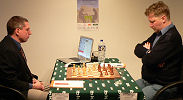


This is the second time the city of Bilbao in the north-west of Spain is paying host to a man vs machine team encounter. The opponents are three former FIDE world champions: Alexander Khalifman, who won the title in Las Vegas in 1999; Ruslan Ponomariov who took it in 2002; and Rustam Kasimdzhanov, who unexpectedly won the title in Tripoli in 2004, beating Ivanchuk, Grischuk, Topalov and Adams in the process. The computer opponents are the following three machines:
Hydra, the hardware project that is being developed in Abu Dhabi, is currently installed on 32 processors of a 64 processor array. Each processor has a special purpose hardware enhancement, a super-fast FPGA chip that executes a critical part of the search and the end node evaluations. The entire system runs at around 1.5 million nodes per second. Why only 32 processors, we asked Dr Donninger? "Because Hydra was optimised for that number," he replied. "I originally defined 'any number of processors" to equal 32, but we are rewriting the program to make it equivalent to 128." So there is a lot of opportunity to make Hydra even faster and more dangerous.
Deep Junior is running on a very fast dual core AMD machine, located in California (why there? Amir Ban: "Because the weather is so good."). Junior is consistently searching at over six million positions per second on this machine. Both Hydra and Deep Junior are connected to the playing room in Bilbao via the Internet.
Fritz 9: This is the latest build of the new Fritz 9 program engine, which the authors have named "Fritz Bilbao". The program is written by Frans Morsch and Mathias Feist, and the latter is operating the machine in this event. Mathias brought a notebook from the ChessBase office, but discovered that my own Dell Inspiron with its 2.0 GHz Centrino and 750 MB RAM was about 15 percent faster. So he confiscated my machine, installed the new engine on it and is using it for the games. Fritz is running at around 1.6 million positions per second on the chessbase.com reporting machine.

Crossing the Swiss Alps to get to Bilabo in Spain
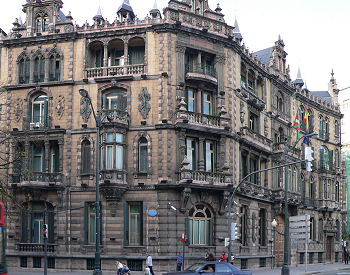
The city is rife with beautiful historical buildings
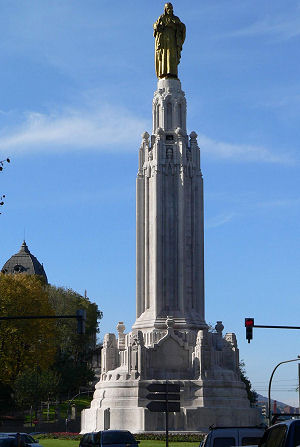
A monument at the center of the town

...leaves no doubt about the faith of this region
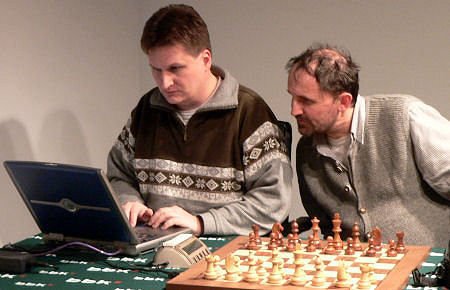
Ulf Lorenz and Christian Donninger test the computer facilities in the playing
room
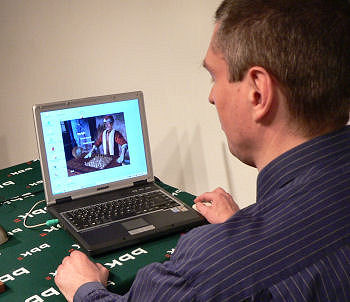
Fritz author Mathias Feist loads the program on his notebook
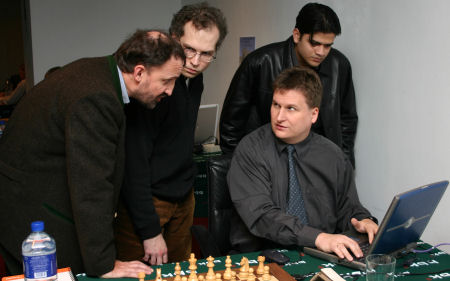
Some internet connection problems at the start of round one: the Hydra system
is located in Abu Dhabi. Above are Dr Christian Donninger, author of the program,
GM Christopher Lutz, chess expert, Dr Ulf Lorenz of the University of Paderborn,
parallel process expert and Akthar Saeed Hashmi, project manager in Abu Dhabi.
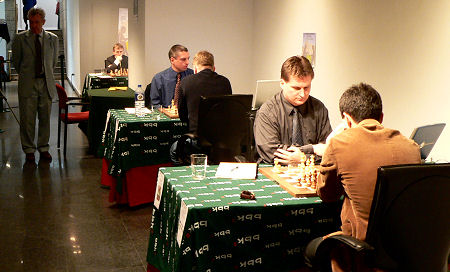
At last all problems are solved and the games can begin. Left arbiter David
Levy.
Frederic Friedel
By David Levy
The game that many people believed would give mankind its best chance against the silicon monsters was Hydra vs Kasimzhanov. The opening was a King’s Indian Defence in which Hydra played a variation with a blocked pawn centre, not particularly wise against a strong human player.
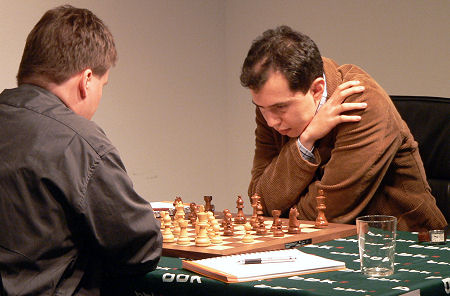
Hydra vs Rustam Kasimdzhanov
The battle soon revolved around the question of which would be the most formidable – Hydra’s pressure on the Q-side or Kasimzhanov’s K-side attack. The program did not appear to have any sort of plan, other than securing a strong looking knight on b5, which eyed the black pawn on a7 and thereby tied Kazim’s a8 rook to a defensive role. Meanwhile Kasim’s K-side attack grew more and more menacing, until eventually there were six, yes SIX Black pieces bearing down on the white king: two rooks, the queen, two bishops and a knight. Black’s only problem appeared to be that in order to bring the sixth of these pieces into the attack, Kasim had to move his a8 rook away from the defence of the a7 pawn, allowing Hydra to capture that pawn.
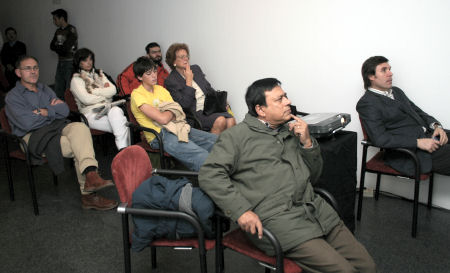
The audience following the games (right Ponomariov's manager Silvio Danailov)
Then all hell broke loose on the K-side, as Kasim completed the advance of his g-pawn, leading to a position with a semi open g-file on which he had already piled up his queen and both rooks in an attempt to break through with a mating attack. But even as Black’s pieces were springing to life and approaching Hydra’s king, move after move Hydra was seen to have magical resources to fend off the attack and to encroach into the heart of Black’s position. The more Kasim tried to prosecute his attack against Hydra’s king, the more hopeless it seemed for Black. Eventually it became clear that Hydra’s judgement had been correct, and the capture of the a7 pawn was sound. After the game Kasim discussed the possibility of delaying the rook move from a8, preparing his attack for a few more moves and only then giving up the a7 pawn. But that is an idea for another day.
Hydra - Kasimyanov [E92]
II Man vs Machine, Bilbao (1), 20.11.2005
1.d4 Nf6 2.c4 g6 3.Nc3 Bg7 4.e4 d6 5.Nf3 0-0 6.Be2 e5 7.Be3 Na6 8.0-0
c6 9.d5 Ng4 10.Bg5 f6 11.Bh4 c5 12.Ne1 Nh6 13.a3 Bd7 14.Nd3 g5 [14...Kh8
15.b4 g5 16.Bg3 f5 17.f3 f4 18.Be1 b6 19.Rb1 Rg8 20.g4 fxg3 21.hxg3 g4 22.fxg4
Bf6 23.Nf2 Bg5 24.Qd3 1-0 Van Wely,L-Zude,E/Munich 1992] 15.Bg3 Qe7
16.f3 f5 17.Bf2 f4 18.b4 b6 19.h3 Nf7 20.Rb1 h5 21.Rb2 Nh6 22.Be1 Bf6 23.Nf2
Kh8 24.Qd3 Rg8 25.Nb5 Rg6 26.Bd1
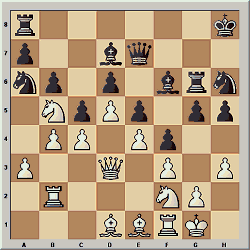
26...Rag8 [26...Kh7!?=] 27.Nxa7 g4 28.fxg4 Bh4 29.Nc6 Qg7 30.Bc3 hxg4 [30...Kh7!?] 31.Nxg4 Nxg4 32.Bxg4 Bxg4 33.Rxf4 Bh5 34.Qf1
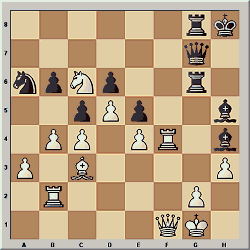
34...Bg3? [34...Bf6 35.Rf5 Qh6=] 35.Rf7+- Qh6 36.Bd2 Bf4 37.Bxf4 exf4 38.Rxf4 Rg3 39.Ne7 1-0. [Click to replay]
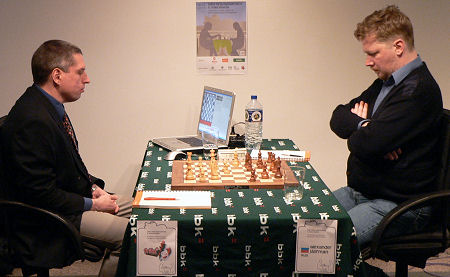
Mathias Feist operating Fritz 9 against Alexander Khalifman
Fritz against Khalifman was more one sided. As White Fritz achieved a pleasant looking position from the Ruy Lopez, side-stepping the challenge of the Berlin Defence by choosing a plan based on the quiet move d2-d3. Khalifman was never able to equalize, while Fritz squeezed and squeezed until Khalifman was forced to saddle himself with an isolated a-pawn. From then on the game looked relatively easy for Fritz, constantly building pressure against that pawn until it fell, leaving the program needing only to demonstrate its technique in order to convert the extra pawn into the full point. [Click to replay]
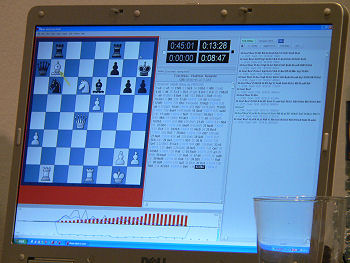
The Fritz screen during the game. Note the evaluation graph at the bottom
of the screen. Red bars indicate a positive evaluation for the computer.

Fritz 9 running at 1.6 million positions per second on a 2 GHz Centrino
notebook
During the opening stages of Ponomariov vs Junior I had the suspicion that Ponomariov had prepared a kind of anti-computer strategy at home and was merely following his preparation. White’s pieces did not achieve a harmonious development but nevertheless the program’s position appeared to have some inherent weaknesses – its Q-side pawns did not appear to be comfortably placed and Black also appeared to be slightly vulnerable along the h1-a8 diagonal. But it turned out that there was no way for Ponomariov to capitalize on Black’s Q-side pawn structure, on the contrary White’s minor pieces were beginning to show signs of being poorly co-ordinated.
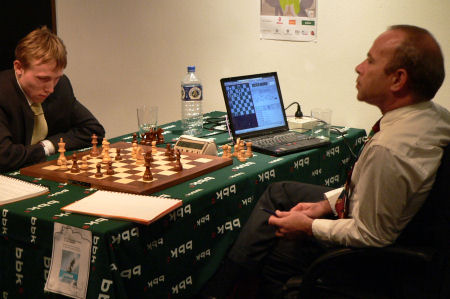
Ruslan Ponomariov vs Deep Junior, operated by Amir Ban
As the game developed it was soon Junior who was making all the running. The program’s pieces soon sprang to life, allowing a tactical shot that put Ponomariov very much on the defensive. White’s king was somewhat vulnerable, being exposed and subject to irritation from the program’s pieces, while although Junior’s own king appeared superficially to be none too safe, it turned out that there was no way for Ponomariov to take advantage. Eventually, when the dust settled, Ponomariov was compelled to shed a pawn in order to extricate his king from trouble, and then another pawn fell, and a third, giving the computer team a 3-0 sweep on the first day of the match. [Click to replay]
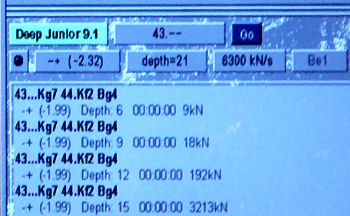
The Deep Junior screen showing the program running at a blistering 6,300,000
positions per second on a dual core AMD machine located in California
How else can one characterize today’s result, other than by admitting the obvious, namely that it was a disaster for the trio of human world champions?
The man vs machine is no stand-alone event. The city of Bilbao is staging a lot of other chess events at the same time, of which we were witness to two very impressive example on the first day of our stay in the Basque metropole.
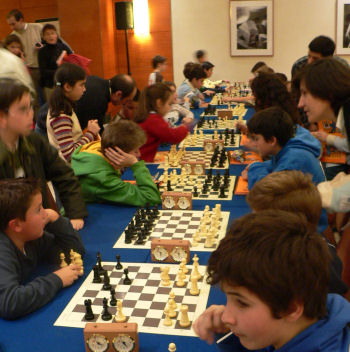
A children's chess tournament with 400 participants
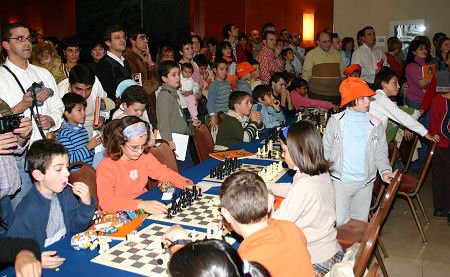
The "niños" are real chess fans, playing with a great deal
of enthusiasm (and even more noise)
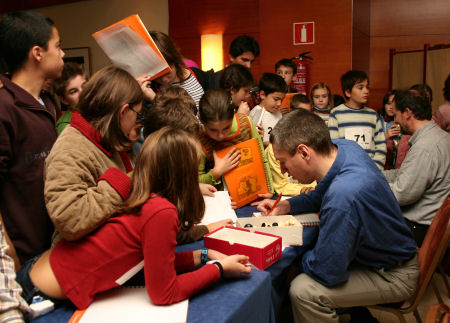
They gather for autographs of the programmers Feist and Donninger
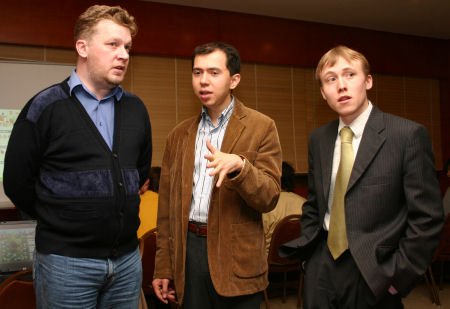
The three world chamions, Khalifman (spelt Jalifman in Spanish), Kasimdzhanov
and Ponomariov visit the children's tournament
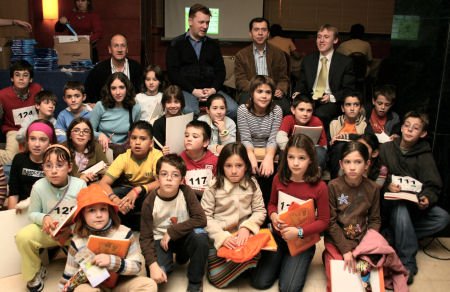
... sign autographs and pose for pictures with the young chess fans
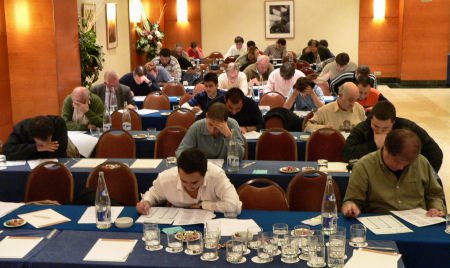
A problem solving competition is also on the agenda in Bilbao
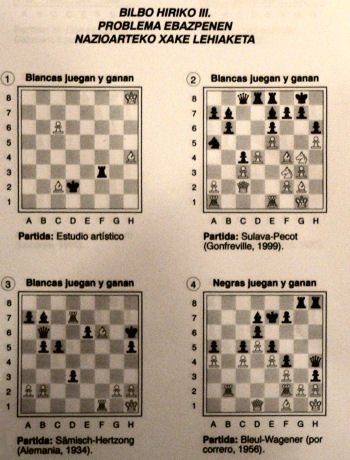
The first page of the 40 problems the competitors have to solve
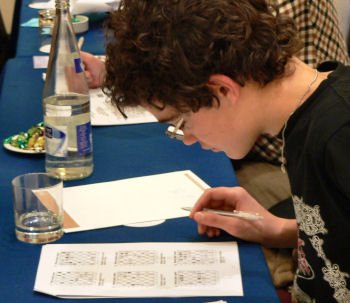
Working hard at chess problems and studies
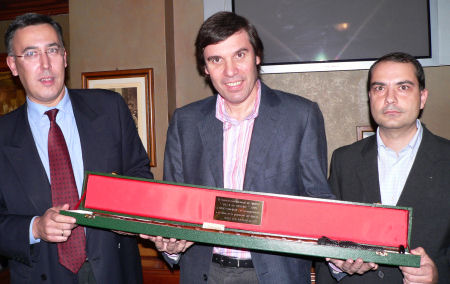
Special guest GM Silvio Danailov (center), the manager of FIDE world champion
Veselin Topalov and former world champion Ruslan Ponomariov, receives a special
"Mayor's staff" from the sponsors.